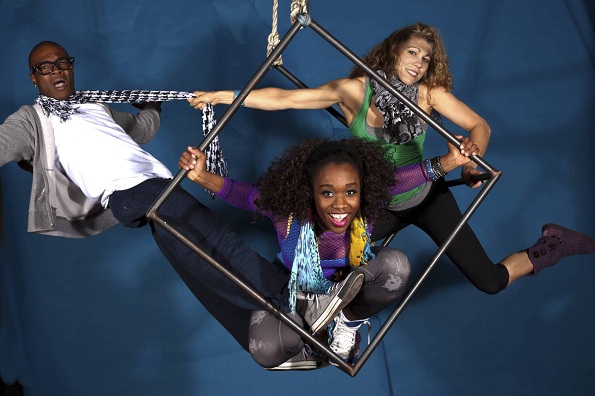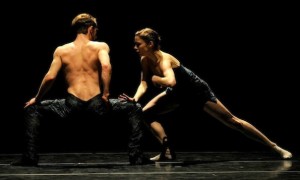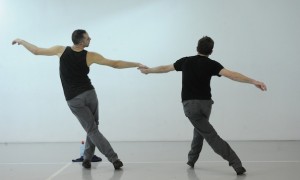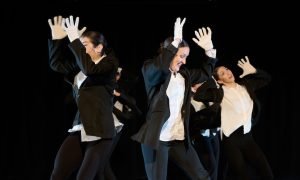By Emily Yewell Volin.
Aerial dance is a genre driven by the constant pursuit to defy dance boundaries by expanding into the vertical space. Aerial dancers incorporate fabrics, trapezes, hoops, ropes, harnesses and other structures into their unique choreography. D’AIR Aerial Dance Theatre, an Atlanta based concert dance company founded in 2007, is a leader in aerial dance. Dance Informa sat down with D’AIR’s Artistic Co-Director Nicole Mermans to learn more about the company and the art form.
The desire to suspend dance in order to create dimension is at the core of all work created by D’AIR Aerial Dance Theatre. And one can’t help but compare aerial dance with Marie Taglioni’s rise en pointe during La Sylphide in 1832. Pointe work and aerial dance have been mistakenly faulted as mere tricks of apparatus. However, both innovations were born from the desire to push boundaries and increase the potential for movement and expressiveness, not from a hope to create spectacle. Nicole explained how California based Terry Sendgraff is responsible for the creation of modern aerial dance. Sendgraff, a modern dancer, experimented with a single point trapeze in the 1970s resulting in the development of her technique to vertically elevate the body. The lineage from this aerial dance pioneer to the D’AIR Aerial Dance Theatre is short. Both Mermans and D’AIR co-director, Andrea Fors, trained with Susan Murphy, founder and former director of Canopy studio in Athens, GA. Murphy trained directly with Sendgraff.
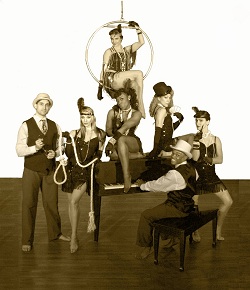
Shad Sterling, Andrea Fors, Fareedah Aleem, Beth Del Nero, Nicole Mermans, Justin Evans, & Shel Swenson. Photo by Keiko Guest Photography
“Part of what makes D’AIR unique is how we stay true to the modern dance roots of aerial dance while incorporating significant circus arts, acrobatics, multiple dance genres and theatrics,” explains Mermans. She adds, “Although there is a lot of cross-pollination between circus arts and aerial dance today, by either bringing traditional circus acts such as flying trapeze closer to the ground or by bringing dance into the air, I believe the biggest difference between circus arts and aerial dance is the intent behind the movement. Circus art is fueled by outlandish stunts and tricks to garner audience applause while aerial dance is fueled by the intent to express oneself, with aerial work just being part of the vocabulary. Aerial equipment helps expand our vocabulary so we aren’t limited to the floor or by gravity. We strive to erase the line between being airborne or on the floor – both are equally valuable in our movement vocabulary. And, if a piece does not call for us to go up or do some big trick, we don’t do it. The equipment may become an extension of our bodies, our most intimate dance partner, or even take on a life of its own. The most important thing is that a story is being told. We use improvisational techniques during the creative phase of our productions and know we are along the right track when we lose sight of the physical function that the equipment plays.”
The D’AIR acronym stands for ‘Dream, Accept, Inspire, Revolutionize’ and these ideals infuse the culture of D’AIR Aerial Dance Theatre. The ensemble members’ virtuosic skills are highlighted by exciting, innovative and humorous performances, which collectively address philosophical themes. “We incorporate so many different elements”, says Mermans. D’AIR currently has four repertory shows that collectively explore philosophical ideas from humorous perspectives. “Audience members are invited to delve into the philosophical origins of the material or to come be entertained. Our shows speak to young kids as well as adults and I think that’s unique in the Atlanta landscape. Part of our mission is to give a voice to everyone – even the tiniest voice is important. I think we speak, in a sense, a lot of different languages and to a lot of different people. Our shows ultimately point to the ability to recognize others within ourselves. The ability to overcome fear on a daily basis translates to everything we do at D’AIR.”
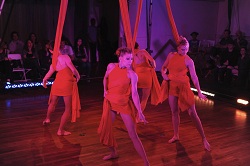
Shel Swenson, Nicole Mermans, Beth Del Nero & Andrea Fors perform. Photo by Steve Carmichael
D’AIR Aerial Dance Theatre company member backgrounds are as diverse as the thematic material the company explores. Mermans shares, “Aerial dancers require a unique skill set that can’t be translated directly from any other movement art. The grace of movement and musicality inherent in dancers make them ideal candidates for aerial dance in many ways. However, going from being a dancer on the floor to being one in the air can be a large learning curve. Core strength is used very differently when we are supporting ourselves from our arms with our legs suspended under us. Dancers often have very developed legs but might not have the upper body strength required for aerial work. Certain gymnasts and acrobats are more accustomed to using their upper bodies, however, we often find that those with super-flexible backs have a harder time accessing the strength in their lower abdominals. D’AIR’s creative process is collaborative and we like to bring in company members with varied movement arts backgrounds. For us, being able to act is as important as the dancer’s physical ability. Our company members must possess strong character and the ability to work collaboratively, be supportive of our mission, and act as strong role models to our youth – all while being generally fun to be around. The current seven member company is comprised of dancers with movement backgrounds ranging from classical ballet, hip hop, cabaret jazz, modern, Latin dance, tumbling and acrobatics. The strength of each of these performers permeates the shows as they carry their dance from the floor into the air. This fusion of form creates unique multidisciplinary and seamless productions.”
D’AIR Aerial Dance Theatre is available for bookings and touring. Learn more about the company and The D’AIR Project at www.dairproject.org.
Top photo: Justin Evans, Fareedah Aleem, Nicole Mermans of D’AIR Aerial Dance Theatre. Photo by Aldridge Murrell


